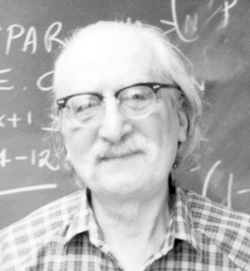Daniel Shanks
| Daniel Shanks | |
|---|---|
 | |
| Born |
January 17, 1917 Chicago, Illinois |
| Died |
September 6, 1996 (aged 79) Maryland |
| Citizenship | American |
| Nationality | United States |
| Fields | Mathematics |
| Alma mater |
University of Chicago University of Maryland |
| Known for |
Computing π Integer factorization Number Theory |
Daniel Shanks (January 17, 1917 – September 6, 1996) was an American mathematician who worked primarily in numerical analysis and number theory. He is best known as the first to compute π to 100,000 decimal places, and for his book Solved and Unsolved Problems in Number Theory.
Life and education
Dan Shanks (he insisted that everyone call him Dan[1]:813) was born on January 17, 1917, in Chicago, Illinois, and he is not related to the English mathematician William Shanks, who was also known for computation of π. He earned his Bachelor of Science degree in physics from the University of Chicago in 1937 and a Ph.D. in Mathematics from the University of Maryland in 1954. In between these two, Shanks worked at the Aberdeen Proving Ground and the Naval Ordnance Laboratory, first as a physicist and then as a mathematician. During this period he also wrote his Ph.D. thesis (completed in 1949), despite having never taken any graduate math courses. [1]:813
After earning his Ph.D. in mathematics, Shanks continued working at the Naval Ordnance Laboratory and the Naval Ship Research and Development Center at the David Taylor Model Basin, where he stayed until 1976. He then spent a year at National Bureau of Standards before moving to the University of Maryland as an adjunct professor. He remained in Maryland for the rest of his life.[1]:813
Dan Shanks died on September 6, 1996.[1]:813
Works
Shanks worked primarily in numerical analysis and number theory, but he had many interests and also did some work in black body radiation, ballistics, mathematical identities, and Epstein zeta functions.[1]:814
Numerical analysis
Shanks's most prominent work in numerical analysis was a collaboration with John Wrench and others to compute the number π to 100,000 decimals on a computer. [2] This was done in 1961 on an IBM 7090 and it was a major advance over previous work.[1]:814
Shanks was an editor of the Mathematics of Computation from 1959 until his death. He was noted for his very thorough reviews of papers, and for being a jack-of-all-trades who did whatever was necessary to get the journal out.[1]:813
Number theory
In number theory, Shanks is best known for his book Solved and Unsolved Problems in Number Theory.[3] Hugh Williams described it as "a charming, unconventional, provocative, and fascinating book on elementary number theory."[1]:814 It is a wide-ranging book, but most of the topics depend on quadratic residues and Pell's equation. The third edition contains a long essay on "judging conjectures." [3]:239 ff Shanks contended that there should be a lot of evidence that something is true before we classify it as a conjecture (otherwise it should be an Open Question and we should not take sides on it), and his essay gives many examples of bad thinking deriving from premature conjecturing. Writing about the possible non-existence of odd perfect numbers, which had been checked to 1050, he famously remarked that "1050 is a long way from infinity." [3]:217
Most of Shanks's number theory work was in computational number theory. He developed a number of fast computer factorization methods based on quadratic forms and the class number.[1]:815 His algorithms include: Baby-step giant-step algorithm for computing the discrete logarithm, which is useful in public-key cryptography; Shanks' square forms factorization, an integer factorization method that generalizes Fermat's factorization method; and the Tonelli–Shanks algorithm that finds square roots moduli a prime, which is useful for the quadratic sieve method of integer factorization.
In 1974, Shanks and John Wrench did some of the first computer work on estimating the value of Brun's constant, the sum of the reciprocals of the twin primes, calculating it over the twin primes among the first two million primes.[4]
See also
- Infrastructure (number theory)
- Newman–Shanks–Williams prime
- Shanks transformation
- Shanks' square forms factorization
Notes
- 1 2 3 4 5 6 7 8 9 Williams, H. C. (August 1997). "Daniel Shanks (1917–1996)" (PDF). Notices of the American Mathematical Society. Providence, RI: American Mathematical Society. 44 (7): 813–816. ISSN 0002-9920. Retrieved 2008-06-27.
- ↑ Shanks, Daniel; John W. Wrench, Jr. (1962). "Calculation of π to 100,000 Decimals". Mathematics of Computation. Mathematics of Computation, Vol. 16, No. 77. 16 (77): 76–99. doi:10.2307/2003813. ISSN 0025-5718. JSTOR 2003813.
- 1 2 3 Shanks, Daniel (2002). Solved and Unsolved Problems in Number Theory (5th ed.). New York: AMS Chelsea. ISBN 978-0-8218-2824-3.
- ↑ Shanks, Daniel; John W. Wrench, Jr. (January 1974). "Brun's Constant". Mathematics of Computation. Mathematics of Computation, Vol. 28, No. 125. 28 (125): 293–299. doi:10.2307/2005836. ISSN 0025-5718. JSTOR 2005836.
